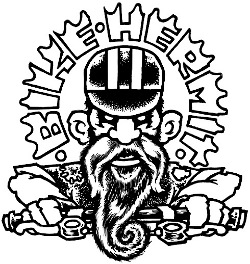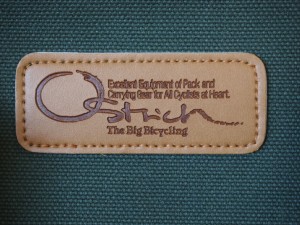The March 2013 Wandering Wheels ride took us from Mountain Home, Idaho to Bonneville Point along the Main Oregon Trail. The trail is easy to find traveling north from Mountain Home on Canyon Creek Road thanks to frequent signage. Once on the trail the surface is nicely graded hard dirt and parts of it could be challenging in wet conditions. The tourist traveling east or west between Mountain Home and Boise needs to be prepared for some sharp climbs, and there is no place to get water for over 40 miles. Camping on BLM land is permitted but there is private land interspersed with BLM so it’s a good idea to get a Surface Management Status map from the Idaho Bureau of Land Management or from the US Geological Survey beforehand.
Author: Bike Hermit®
A Touring Bike
This is the text of an email I sent to a customer who asked some questions about what makes a good touring bike:
A touring bike should be about comfort. Typically the tourist is not going to be doing too many short, hard efforts or sustained efforts in a paceline. Rather the tourist is concerned about riding at a moderate pace for a long time….6 or 7 hours or more.
-An extreme drop in height from the saddle to the handlebars, while allowing the competitive rider to take advantage of aerodynamics, might not be as comfortable on an all day slog at a moderate, steady pace.
-Tires are a major factor in comfort…use tires with 28mm minimum nominal width and 32mm or 35mm would be better. Don’t fall into the intuitive trap that hard skinny tires are faster. They aren’t and they beat you up on a long ride.
-You already mentioned fenders and we think they are essential, plus a bike doesn’t look right without them.
-Balance your load front and rear with more weight on the front (if the bike’s trail is suitable) On a good touring bike this will help stabilize the ride and steering. Your own weight on the bike is distributed about 60% rear and 40% front and adding more weight to the rear only can affect handling. We like Ostrich or Berthoud front rack top “rando” bags because they sit right on top of the front wheel/fender for a low center of gravity, they are easily accessible, and they have map cases.
-Drop handlebars offer more hand positions for long days and if the bars are up higher the drops are actually usable!
Get a traditionally spoked, cross three wheelset with minimum 32 spokes and 36 if you are heavier than 160 or so. Mavic or Velocity rims… they are the best.
Arguably, a good dynamo hub with a permanent headlight is a necessity. I think so.
We are big fans of leather saddles, for too many reasons to explain here.
A compact double crank set could work if you have a wide rear cassette and/or if you will not be doing much loaded touring. A triple is nice on loaded tours. 25 gear inches or less would be the recommended low range for loaded touring.
OK, you asked a loaded, open question. Hope I got close to answering it.
Regards,
Jim
Bike Fit
On The Bike is a bike fit service collaborating with Boise State University’s Center for Orthopaedic and Biomechanics Research. We met Benjamin Stein, the man behind On The Bike when he stopped into Bike Touring News World Headquarters (BTNWH) a few months ago. We asked if we could come see his operation and write a blog post about it and he graciously offered a complimentary fit session to me.
http://youtu.be/MLqZR0XvoUA
Even though I have read almost everything I can find on the subject and I am trained in a prominent “laser precision bike fitting” system, I am not a bike fitting professional. That does not prevent me from holding forth on the subject in my series of articles on bike fit. What I do know is that riding a bike efficiently is neither simple nor intuitive… there are a lot of moving parts and we simply can’t tell what our own bodies are doing. But the cyclo-tourist needs to be able to ride efficiently and in comfort for long periods, and while I’m not saying that a professional bike fit is required for bike touring, a set of trained and critical eyes can help identify changes that might need to be made to improve enjoyment and to prevent injury.
On The Bike’s approach to fitting a rider on the bike seems to be holistic. Beginning with an interview, Ben gets a feeling for the person’s history and their goals. Then he observes as they perform a range of prescribed activities including knee bends, squats and simply walking. Then, with the rider flat on his/her back Ben assesses flexibility and looks for asymmetries or discrepancies in leg length and so on. Then reflective dots are affixed to strategic locations on the riders body. These dots will be picked up by the 8 motion capture video cameras arrayed around the bike, which is on a stationary trainer. As the rider rides, a computer compiles all the motion capture information and displays a 3-D video representation of the rider- a representation of the skeleton of the rider actually. Using this video Ben can confirm how any asymmetries affect the rider’s pedaling motion and he can see other issues which might be important but cannot be seen in a static view.
As I was pressing Ben for formulas or rules of thumb he might use for things such as saddle height or crank length it became apparent that he didn’t have any dogmatic rules or guidelines… which I can appreciate, since no two people are exactly the same. With his background in physiology (Ben holds an M. S. degree in Exercise Physiology with a bio-mechanics emphasis) he can see how a rider’s body interfaces with the bike and make recommendations on how to achieve a better range of motion or better use of a muscle group.
I came away with a better understanding of just how complicated achieving a comfortable, efficient position on the bike can be. All those moving parts need to work together and changing one component, simply moving the saddle forward for example, changes the relationships of all the other parts. That recognition and appreciation may be one of the values of what Ben Stein is trying to do with On The Bike. When he then makes suggestions or observations based on his background and experience it can help the rider understand the reasoning and be more aware of what their body is doing.
To the person considering getting fit on a touring bike I would say; Beware of formulaic, rigid bike fitting “systems” and quickly move away from anybody who claims they can provide the “perfect” fit for you on the first try. Most of these people focus on performance or racing. Racers and tourist have different needs. The tourist will not be sprinting or trying to cheat the wind to go faster and their touring bike has a different geometry than a racing bike- plus it will be loaded, and so it will handle differently. Somebody like Ben who knows enough about physiology to be flexible in their approach will be best for the touring cyclist.
Respect(s)
Anybody with a computer and an internet connection can have a blog. A cynic might assume that since the entry barriers are so low bloggers might be shallow and narcissistic and their blogs trivial and insignificant. And since traditional journalism has fact checkers and editors it is, in theory at least, reliable. What’s to certify that a blog or blogger is accredited or has value?
In reality, the blogosphere reveals to me that there are many, many smart, articulate people out there with much to share. People who might not get a chance to share without the internets.
In “The Importance of Respect” from The Stone Mind blog Justin writes ” When we come to a climb without respect or an interest in learning, we see nothing but a goal to be achieved. In such a state, we might wish to skip to the end by any means, as a child who moves his piece to the final square of a board game and mistakes himself the winner. We might want to announce our accomplishment or log it on a scorecard, but what we have really learned cannot be verbalized or assigned a numerical value“.
The sentiment applies to bike touring. Choosing to travel under my own power means I need to be aware and mindful of where I am. Because I don’t have any choice…I’m not going anywhere very fast. Having self-appointed expectations leads to self-induced disappointments. When I hear somebody say they want to ride the bike across the US I want to ask; Why? If it’s because they love being out on the bike for hours on end and the feeling of freedom that goes with it, then I think that’s great. If they have something to prove to themselves or to somebody else, I think why not stay home and train for a triathlon. There are too many things beyond our control on a bike tour to have unwavering goals. If we get sick or injured or have a major mechanical or simply get discouraged and decide to go home, it shouldn’t be seen as some sort of failure. I just realized that my recent tours have probably been too goal oriented. I gave myself a certain amount of time to cover a certain distance and I set it more or less in stone by purchasing airline tickets in advance. I think I’ll do an open ended tour next time. I’ll just start riding and when I run out of time or motivation, I’ll quit. In between, I’ll try to pay attention and to be present and humble.
Blogging has the power to form connections between people. I used to read the entries of a gentleman living in Bayou Blue, LA who went by the name Old Fool. He wrote about simple chores around his home, about his wife, bicycles and sometimes, obliquely, about politics. I got the feeling there was some anger, but he never came across as hateful.
Old Fool’s last post indicated he was having some difficulty typing, and I recently learned (from another blogger) that he suffered a stroke and passed away in September, 2012. I couldn’t understand how I could feel so sad about somebody I didn’t even know. But I sensed a humble person, one with a kindred, eremitic spirit. It has been another reminder to me that I have little control over events.
R.I.P. Old Fool.

There are two occupants in the grey Honda Element and as they drive past me the passenger shrieks some sort of primal scream. I don’t think it is meant as encouragement to me. I don’t think I did anything to irritate these people, but maybe I did. Maybe I forced them to slow down or maybe they thought I was taking up too much of the road. Maybe they don’t like the way I look. Maybe their brains are scrambled from too much TV. Contravening my own guidelines, I take one hand off the handlebars and give them the universal sign indicating I think they are number one. Up ahead, impeding upon their forward progress is a stop sign, and seeing them slow down I increase my pedaling cadence in the hopes of overtaking them in order to assess the source of their obvious displeasure with me riding my bicycle. Briefly I wonder what I would do if I overtake them. Will I need some protection? What about the frame pump? Oh yes, I think, I have a can of pepper spray in my bag. Emboldened by that realization, a couple miles later, when they overtake me again, and the passenger issues forth with another similar greeting, I respond in kind and suggest they stop in order to discuss our grievances in a civilized manner. They don’t stop. By that time I have the pepper spray strapped to my hand and if they do stop and the conversation is less than civilized, at least we will have some entertainment. This is a scenario I have played over in my head ever since Juan Butler knocked me the fuck out after a similar altercation a few years ago. Since the pepper spray would only temporarily disable my assailant(s) I would need to grab the car keys and take them with me….otherwise I would be like a sitting duck on the bike once the driver recovered.
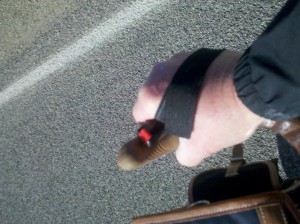
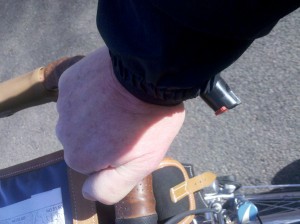
I have ridden my bike through two dozen of these United States. So far I would have to say that Texas is my favorite place to tour on a bicycle. The shoulders are broad and the drivers are courteous. Many people stop to see if you are OK or if you need anything or just to shoot the breeze, and sometimes to offer a place to stay. Me and Gary P. Nunn are down with Texas;
“the friendliest people and the prettiest women you’ll ever see“.
I would have to say that the state I’ve called home for the last two and a half decades is my least favorite place to ride a bike. In fairness to Idaho I’ve spent many more hours on the road here than any other state but over the years, having motorists yell at me has been the least of my worries. I have had plastic liter bottles and water balloons hurled at me from moving vehicles. And it was here, in Boise, that the aforementioned individual stopped his car and physically assaulted me. The only other occurrence that comes close was in the Smoky Mountains of Tennessee when a car drove up behind me so stealthily I didn’t even hear it and the passenger tapped me on the butt as they slowly drove past. I think Clem was just trying to be friendly though so I can’t even get mad about that.
Now, far be it from me to agitate the already turbid waters of motorist/cyclist relationships. I do not advocate for any sort of reaction or retaliation for alleged wrongs of either party. I don’t place any blame nor do I hold out much hope for advocacy to change behaviors. I just want to ride the bike. I always ride defensively and I go out of my way to avoid confrontations with automobile drivers. But I will not let some confused, angry and ignorant people keep me from doing what I enjoy. Ignoring the fact that there are simple minded, people who are frightened, stressed out, hurried, bored and over-stimulated all at the same time, while behind the wheel of a car, is not wise either.
I also want to make it clear that, in my experience, drivers are much more courteous to riders in normal-ish clothing and with racks and bags on the bike than to riders dressed in racing strip. I have NEVER been harassed by motorists when touring, in fact the opposite is true- people are generally curious and very friendly…..or else they just ignore you because they think you are a little bit crazy.
The tactical flashlight as a means of self defense was meant as sort of a joke but if our goal is “Empowering the Bicycle Traveler” I feel I would be derelict not to address the very small chance of needing to defend oneself. I bought my pepper spray at the local Cop Shop and it is set to shoot a stream of spray. Pepper spray is legal in all 50 states but I don’t claim to know all the details of the legality of its use. I assume that in a legitimate self defense situation a person would be justified in using it. I also assume that simply riding up to a stopped car and spraying the person who just yelled at you would probably not be cool.
I don’t understand why we are so mean to each other. We get to drive our cars and go out on our bikes but we are still not satisfied. We feel the urge to fight with each other and mark our territory. Human nature I guess. Unfortunate, but I think one needs to be realistic.
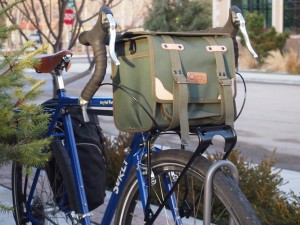
Not precisely “handlebar” bags these Ostrich bags are supported on the platform of a front rack and secured at the top either to the handlebars or by a bracket known as a decaleur. In my opinion the advantages of this style of bag are several:
–The center of gravity is lower than a bag attached to and supported by the handlebars
-The bag is more accessible from the cockpit than panniers.
-An assortment of small pockets make it easy to find the small things you need
-A plastic covered map case is indispensable to the touring cyclist.
-Relatively easy to remove and carry when off the bike. Some come with shoulder straps.
As of this writing their are two sizes of front Ostrich bags (Ostrich also makes a traditional style saddle bag and, I believe, rear panniers); the F-104 and the new, slightly larger F-106.
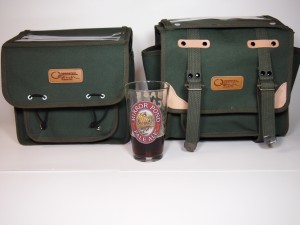
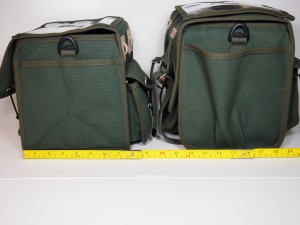
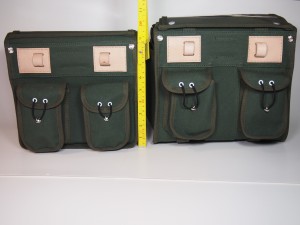
Determining which size bag will work best on a particular machine starts with knowing the distance from the top platform of the rack to the handlebars. The type of stem on the bike -threadless (Aheadset) or threaded (quill)- and, in some cases, the steer tube diameter – 1″ or 1 1/8″- will tell what type of decaleur to use. Gilles Berthoud decaleurs are available in six different configurations, and Velo Orange decaleurs in two. We carry all of them in the Bike Touring News Store and,as always, are here to help demystify.
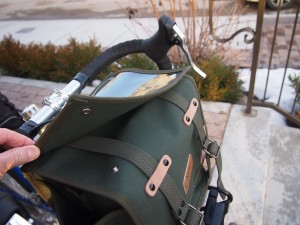
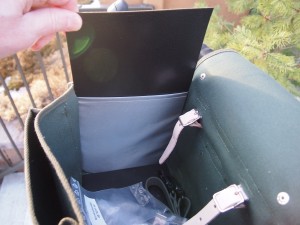
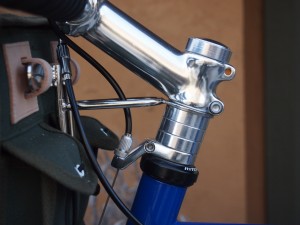
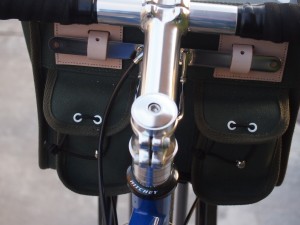
I’ve always liked these bags. I’m a sucker for canvas duck and for the army green color. I like the robust, utilitarian feel and look of these and I think the details are well thought out. The relative voluminous capacities are nice too. When touring it seems as though I’m always looking for the extra pocket or for someplace to lash the rain jacket. These have been unavailable in the US for some time but I’m excited about being able to get them again.
UPDATE 2/19/2013
We will also be carrying the Ostrich Panniers…..
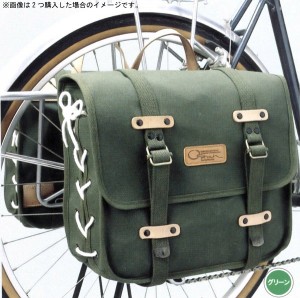
….and the traditional style Ostrich S-2 Saddlebag...
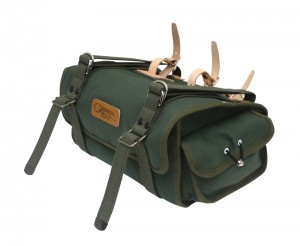
MORE UPDATES! 3/15/2013
We now have the Gilles Berthoud rain covers which work nicely with the Ostrich F-106 and F-104 bags.
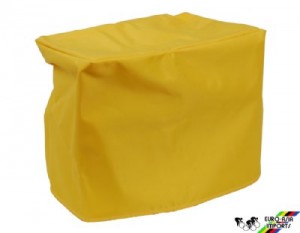
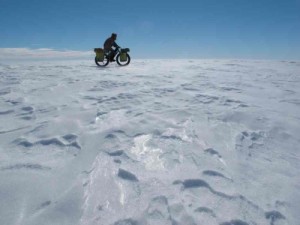
It’s eerie to listen to the voice. The transmission starts out chirpy, almost a forced chirpyness. As the voice goes on, loneliness and a sort of uncertainty come through. The voice is not real time but it’s still chilling to realize it’s coming from the middle of the Antarctic, the middle of that frozen desert. He’s alone. I can see pictures of him crouched in the orange glow inside the little tent, or huddled beside the bike trying to get out of the wind.
Eric Larsen just returned from an attempt to ride a Surly Moonlander to the South Pole…and I complain about a little bit of snow on the local roads! Spoiler Alert: He didn’t make it. At first he saw it as a failure, but on the ride back to the pickup point it sounds as though he started to enjoy the routine. That brings to mind a paradox; one needs a goal when setting out on a journey, but if the ultimate, original goal is not reached, is that necessarily a failure? What is the point of the journey after all? Sure, Eric had sponsors and he felt as though he let them down but at the same time he was being realistic. He calculated that he would be out of supplies before he reached the South Pole. How would his sponsors look and feel if he died?
Tom Allen set out on his own journey. He didn’t know what he was looking for, but when he found it he was self aware enough to know it. And lucky for us, he made a movie titled Janapar. We will be screening it twice this month (January 2013) so if you want more information about that leave a comment.
Paul Salopek is planning to walk from Ethiopia and across Asia before crossing over to Alaska and continuing the length of the North and South American continents, ending up at the “end of land”. That’s 21,000 miles. On foot. What’s scary is that I sort of get this trip. He is a journalist and his “goal is to cover the major global stories of our time by walking alongside the people who live them on a daily basis”. To me the hardest part of this trip would be the mental aspect. He plans on walking for seven years. Thinking about reaching the end, or even the day’s stopping place- o n f o o t- might drive me mad. His website is called Out of Eden
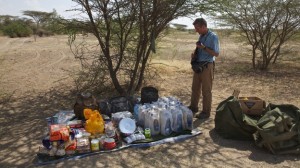
NPR.ORG
Ever since I read “How To Use A Flashlight Tactically” on the Art of Manliness (yes, that’s for real) blog I have wanted a tactical flashlight. A tactical flashlight is not much bigger than the palm of the hand, has a bright LED beam, is made of impact resistant material, is waterproof and has a robust, shielded on/off switch. Technically a tactical flashlight would have “striking” bezel, a hardened aluminum piece which is scalloped or shaped in such a way that the flashlight can be used as a tool or for self defense. OK, I admit that if faced with the situation, I’m not sure I would have the wits or the skill to use the flashlight to temporarily blind and disorient an assailant long enough for me to get away or to punch him out. But the thought that I could is somehow comforting.
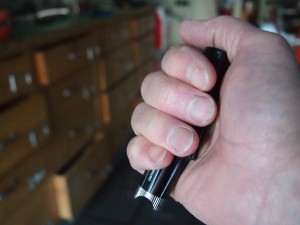
My new flashlight is small enough to conceal in my fist with only the bezel sticking out and the on/off switch cradled against my thumb. And it has a metal clip to secure it to the pocket of a bike bag for quick access, or to attach it to the brim of a baseball cap so I can use it as a headlamp.

On a related note:
Brother David Sunshine (pretty sure that’s his given name) posted on the Surly Bikes blog an article about his survival kit. While we’re not necessarily preparing for the apocalypse….we’re just going bike touring…..there are some good ideas for what to take with. And the specifics will change for each person depending on where they are going; a trip around the San Juan Islands in Puget Sound is different than riding the length of the Baja.
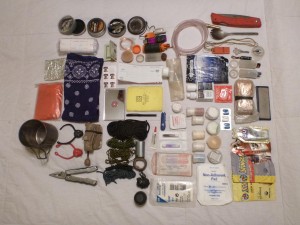
I can see that my own survival kit needs some work. For backcountry touring I want to get a signal mirror and a compass. And my fire starting skills could be improved. I should carry a fire steel and learn how to use it. When I was in Boy Scouts we spent a lot of time building fires. If you couldn’t start a fire with only one match and without paper, it could be embarrassing. So much of the fire building process was in the prep…plenty of dry tinder, several stacks of dry twigs in graduated sizes, then larger sticks and logs…and in the structure….making a teepee shape over the tinder out of the smallest dry twigs and slowly adding bigger twigs as the flame grew. What I did not know until I read this is that inner tubes will light on fire pretty easily. So having several strips cut out of old inner tubes means I will always have fire starter. Not sure that would have qualified in the Boy Scouts but, oh well.
The temperature is going to be well below freezing this New Year’s Eve day and several inches of snow have fallen in the last 48 hours. A combination of de-icer, sand spread by the highway district and traffic has left the busiest roads mostly bare and dry. But driveways and side streets are covered with (one after another, or all at the same time) patches of snow, ice, slush and gravel. I’m not riding the bike today.

This morning I looked in a supplier’s catalog at tires with 400 or so carbide steel studs in the tread. I’m tempted to buy a pair but I’m not sure if even that would keep me upright on the ice. And the use for such tires is limited…I don’t really want to be taking them off and putting them back on every time it snows. If I had a bike with disc brakes I could try the old zip-tie snow chain trick.
Earlier this month, before the snow was sticking, we went on a day trip from Three Horse Winery north of Eagle, ID to Montour, ID where we ate lunch before riding back. Scott and Aileen scouted this route prior and they were going to show us the fabled passage between Eagle and Montour which we had been unable to discover on our overnight trip last year. This turned into sort of an epic slog through mud and water and emphasized the importance of the right bike for the job… those of us with fenders spent quite a bit of time digging packed mud from between the tires and fenders. We even ended up taking Sky King’s front fender off when her front wheel completely bound up and stopped turning. For those on bikes without fenders and using disc brakes the going was relatively easier.
Here is a map of the route for those who might want to repeat it.
Even with the mud everybody had a great time and there was more smiling taking place than cursing although there was some of both. That is partly a testament to the cohesiveness and the great attitude of our fledgling bike touring group wherein everybody is quick to help others and nobody complains. Plus, every rider is competent and able to take care of themselves on and off the bike.
A touring bike continues to open my eyes to the scenic and solitary places within an hour or two of where we live. Places I never visited in the previous two decades of living here and probably would not have experienced in another 20 years, but which are suddenly accessible on my country bike. Not to mention a new group of friends….a group of thinking, entertaining and interesting people who make this hermit happy to be a part of it.
New Theme
So….a couple of things:
……A new look for the site has been in the works for a while. While there has been no wailing to speak of, there has been some gnashing of teeth deciding how we want the site to look and how to organize it. And it’s still a long ways from finished, but we have the new theme installed! How do you like it so far?
…..This came yesterday:

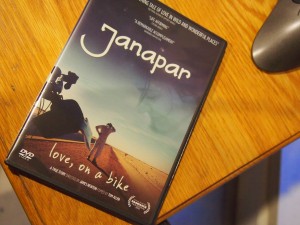
This is a film Tom Allen made about his 12,000 mile bicycle odyssey. We bought the DVD and Tom sent us a complimentary download of the HD version for our screening in January. If you want to see it make sure you sign up for our newsletter because that’s where we will be announcing the screening date. Here’s a trailer:
….The Ace Hotel in Portland had Jordan Hufnagel make four bicycles which they rent to guests at the hotel. Pretty good reason to stay there!
Hufnagel Cycles for Ace Hotel Portland from Ace Hotel on Vimeo.
Thanks for visiting Bike Touring News! Over time the site will evolve and it should become easier to navigate so add the RSS feed to your feed reader or bookmark this page and keep up to date.
